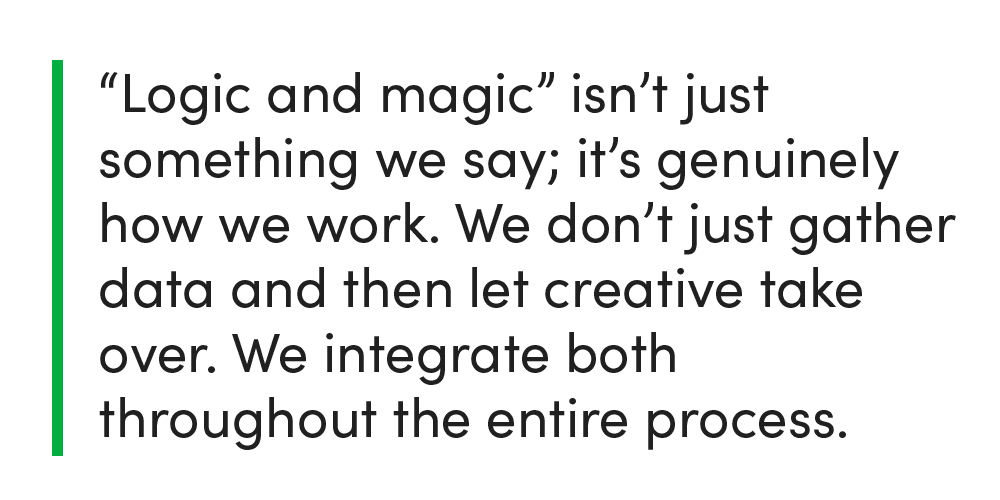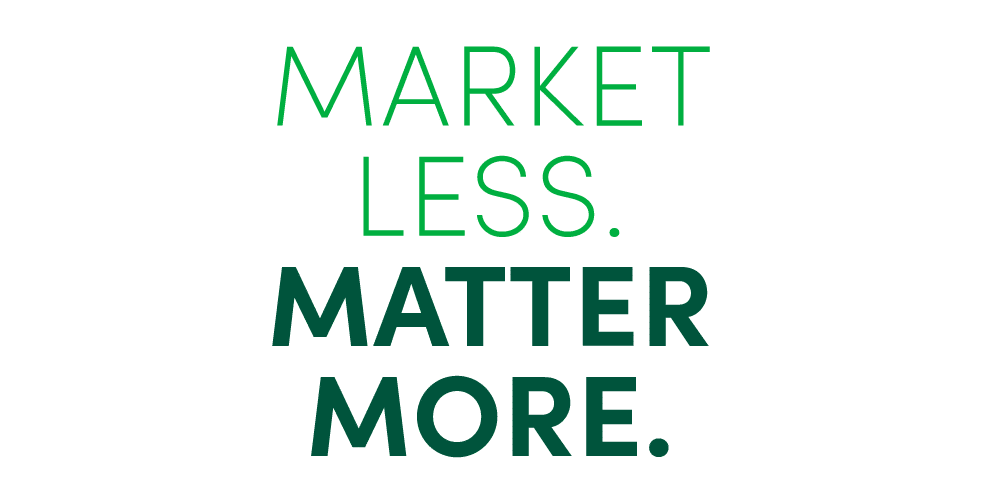Leadership Lens is a series in which we feature Leap Group leaders discussing industry trends, shifting landscapes, and other topics crucial to brand relevance.
In today’s marketing world, data reigns supreme and creative risks often feel, well… risky. So, the idea of balancing logic and magic has never been more relevant—or more necessary. For more than two decades, Leap Group has grounded its work in this duality, bringing together analytical insight and emotional resonance to build brands that not only perform but build lasting connections—and consumer loyalty.
In this month’s installment of Leadership Lens, we sit down with Alan Gilleo, Leap Group Co-Founder and CMO, and Kenny Friedman, Executive Creative Director, to explore the origins of logic and magic and how it continues to shape the way Leap teams think, create, and lead. From challenging the culture of incrementality to advocating for bold, insight-driven storytelling, Alan and Kenny make the case for why brands need both sides of the equation to truly matter in the market—and why these days, the biggest risk might be playing it too safe.
The concept of logic and magic has been embedded in the Leap Group culture for the past 26 years. Alan, could you talk about the origins of that and how logic and magic continue to influence Leap processes?
Alan: I co-founded Leap with Dan Knapp in 1999. Dan’s a CPA, and I was a designer. When we went into pitches, we would lean into this dynamic, with creativity on one side and business logic on the other. Then, we created a white paper to share our thought leadership on advertising and strategy, which is when the phrase “logic and magic” emerged.
In the advertising and marketing space, real impact comes from combining data-driven consumer insights with creativity. If you understand what consumers—or buyers in a B2B context—are looking for, and you combine that with emotion and storytelling, you can create something truly meaningful.
Even though we like to think we make decisions based on logic, research shows we actually decide based on emotion. So, if you can invoke an emotional response—whether through humor, sentimentality, or a sense of community—you can influence behavior and decision-making. That’s “logic and magic.”
Kenny, how does “logic and magic” influence you as a creative director?
Kenny: “Logic and magic” isn’t just something we say; it’s genuinely how we work. We don’t just gather data and then let creative take over. We integrate both throughout the entire process. Many agencies work in a sequential way—logic first, then magic. But we work together the whole time.
For example, websites are very structured and logical, but they also need to resonate emotionally. A site can be perfectly functional, but if it lacks beauty, compelling copy, and a human connection, it won’t be effective. Conversely, if it’s only beautiful but lacks usability, it’s more of an art piece than a brand tool. The two have to come together.

Alan, how do you see Leap’s unique structure as a bespoke holding company supporting the idea of logic and magic and that integration?
Alan: Our entire structure supports that concept. We have the research team, which focuses on uncovering actionable insights, and the analytics team, which tracks what’s working and what people are responding to, allowing us to pivot when needed. Together, they create insights that fuel the entire agency—whether for creative, media, or performance marketing. Those human insights infuse our process in a big way.
That said, we always have to be careful that data doesn’t become a hindrance to creative teams. I think the rise of big data and analytics in marketing has really throttled creativity. Too many brands and marketing managers use it as a crutch to avoid making bold moves. And the irony? The data itself tells us that emotional, creative work is what truly drives results. Harvard Business Review did a study that showed great creative actually sells. And yet, we still have to fight to convince brands of that.
“People sometimes confuse logic with data. Logic is strategic thinking. Data is something different. But many people lean so heavily into data that they stop thinking critically. “
Kenny: They want to see if something is going to “click” before they take a risk. Testing is valuable, and we do test, but we don’t just take test results at face value.
If you’re doing something truly new, it’s not going to test well—because people aren’t expecting it.
Creative gets diluted by algorithms. Instagram and TikTok serve content based on what people are already engaging with. So, culture starts repeating itself. Suddenly, brands want to copy whatever’s trending, rather than doing something original. But first—does it even make sense for your brand? Second—if you jump on too late, it’s just noise.
When brands rely only on data, they often default to the safe, boring choice. That’s the key difference between data and logic. Data tells you what’s happening. Logic tells you why it matters. You have to go beyond the raw data and interpret it strategically.
What do you say to clients to encourage them to take creative risks, to really lean into emotion and magic?
Kenny: A lot of people are scared to take that leap. Our clients’ performance is rooted in data. They’re measured by what they did last quarter, not by what they did five years ago that built long-term success. That makes it tough to take big creative leaps.
So, we’ll say, we understand you want to be more conservative. But let’s take 20% and do something different. Let’s take 10% and test something. If a client trusts us and truly wants to take risks, they’ll be open to those tests. Sometimes, it’s about reminding them of what they originally asked for. We show them why we made the creative choices we did, why it’s grounded in great design, great copy, and a solid insight. And we encourage them to take that leap of faith.
Alan: We’ve created a culture of conformity in marketing departments. A culture of incrementality. Incremental growth shows success, keeps the numbers moving, and keeps them safe. There’s no real incentive for most marketing decision-makers to push for a big, game-changing creative move. But if brands really want to stand out, someone has to be willing to take a chance. That’s where insights and data should come in—not to justify playing it safe, but as a tool to strategically lean into the right creative risks.
Can you talk about how logic and magic relate to the idea of Market Less, Matter More?
Kenny: Performance marketing alone can only take you so far. Branding is what makes people fall in love with your brand. I only buy Vans. There are other shoes I like, but I’m so bought into Vans that I don’t even consider other brands. It’s illogical, but that’s what great branding does. And if brands don’t invest in that emotional connection, they’ll always be stuck chasing the next performance ad.
Alan: With Market Less, Matter More, some people think we’re saying, Spend less money. That’s not it. We’re saying: Be real. Be genuine. Put something out there that people actually care about. We’re all tired of irrelevant marketing. Even those of us in the industry are exhausted by the sheer volume of meaningless content.

It all comes down to calculated risk—which is where logic and magic come in. Get the right information to make smart, logical decisions—but also put something out there that will create emotion. That’s how you cut through the clutter. It’s logical that something interesting, beautiful, and emotional will perform better—so why fight it? If brands want to break out of this incremental growth cycle, they have to make a real decision. And that means doing something different.
Kenny: Take Nutter Butter’s recent acid-trip aesthetic. Someone in leadership was willing to take that risk. Maybe it was Larry the intern who got a chance to run wild for a week or a month. Worst case scenario? They delete some posts, ignore the feedback, and move on. But someone in that organization had the guts to try. And that’s what I always bring up when account teams say, What if the client doesn’t like it? What if the audience doesn’t respond? Well… what if they do? Because if you start with the assumption that something won’t work, you’ll never do anything interesting.
Because now, if I’m in the store and I see Nutter Butter, I might think, Why not?
And if I try it and love it, I’ll buy it again. That’s how brand-building works.
Alan: Exactly. Market Less, Matter More means putting something out there that people actually care about.
Any advice to CMOs and marketing leaders about logic and magic?
Kenny: I think brands need to be okay with failure. Because when you try something new, there’s always a chance it won’t work. But that doesn’t mean it was a bad idea. It just means it didn’t perform the way you expected. So learn from it.
If your first big creative risk flops, don’t say, Well, that didn’t work, guess we’ll never try again. Try something else. If your psychedelic Nutter Butter campaign didn’t land, maybe humor will. Maybe ASMR will. Maybe an emotional story will. The point is—keep experimenting. If you don’t, your brand becomes stagnant.
Alan: That’s why brands should always have a culture of testing. Even if it’s just 5-10% of the budget, set aside money to try new things. And from a leadership perspective, CMOs and CEOs should create a culture where experimentation is encouraged. A culture where failing fast and learning is part of the process. Testing isn’t failure—it’s information that guides the next move.
Kenny: The best clients are the ones who embrace that mindset. We love clients with guts. Clients who are willing to try something new. If you want to take creative risks, we will be right there with you. But you have to be willing to leap. Because that’s the only way to move forward.
Alan: Exactly. That’s why Market Less, Matter More works. Because when you take risks—when you try and fail, try and fail, and try again—you get to the ideas that actually matter. We’ve created a culture of fear in marketing. Unless there’s a stat to back it up, no one wants to take a stand. But here’s the thing: incrementality won’t make you stand out. And the brands that break through? They have leaders willing to take a stand.